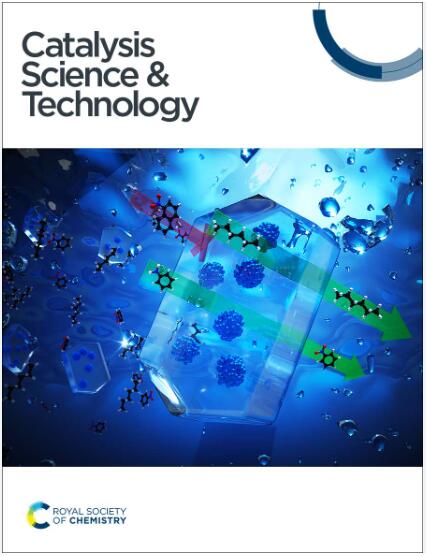3d-metal based anodic pincer electro-catalysts dispersed in solution for the electro-catalytic oxidation of (m)ethanol†
IF 4.4
3区 化学
Q2 CHEMISTRY, PHYSICAL
引用次数: 0
Abstract
Using banana-leaf extract as the reducing agent, a green protocol has been formulated for the synthesis of Ni/Co/Cr based metal oxide/hydroxide nanoparticles starting either from their metal salt precursors or from their bis(iminopyridine) pincer complexes. Thorough characterization has been performed using powder-XRD, FESEM, FETEM, XPS, MALDI and FT-IR analysis to infer the phase, morphology, size and chemical composition of these heterogeneous particles. The nano-particles (NPs) derived from (iPr2NNN)CoCl2 containing CoO2 and Co3O4 mixed phase oxides possessing a spherical morphology turned out to be superior among the 12 nano-catalysts that were screened. While a current density of 24.90 ± 10.74 mA cm−2 and 260.06 ± 3.06 mA cm−2 was obtained for methanol electro-oxidation (MOR), a current density of 33.39 ± 1.28 mA cm−2 and 235.03 ± 4.03 mA cm−2 was observed during ethanol electro-oxidation (EOR) at room temperature in NaOH as the supporting electrolyte using a carbon based electrode assembly. At 60 °C, the current densities in the (iPr2NNN)CoCl2 NP catalyzed MOR increased up to 222.23 mA cm−2 and 451.32 mA cm−2 at a lower potential of 0.69 V and 1.22 V vs. Ag/AgCl. The electro-oxidation is majorly complete with zero evolution of CO2 as it gets trapped by the supporting electrolyte as a value-added chemical Na2CO3. For the MOR and EOR, up to 98% and 82% respectively of Na2CO3 were obtained after 12 hours of controlled potential electrolysis. The (iPr2NNN)CoCl2 NPs were also found to be highly stable and fairly active with a current retention of 78.60% and 64.0% for MOR and EOR respectively. The catalytic activity and the yield of Na2CO3 obtained with the top-three best of the considered catalysts had a linear correlation with the electrochemical active surface area (ECSA), CA stability and current retention along with the diffusion coefficient while following the trend (iPr2NNN)CoCl2 NPs > (Ph2NNN)NiCl2(CH3CN) NPs > (Ph2NNN)CrCl3 NPs. In this work, a unique approach of suspending the electro-catalysts in solution rather than using them on bulk electrodes has been executed to probe their electro-catalytic activity towards (m)ethanol which not only leads to high current densities but also generates industrially valuable Na2CO3.
分散在溶液中的阳极钳型 3d 金属电催化剂用于 (m)ethanol† 的电催化氧化
以香蕉叶提取物为还原剂,从金属盐前体或亚氨基吡啶螯合物出发,制备了镍/Co/Cr基金属氧化物/氢氧化物纳米颗粒的绿色方案。通过粉末xrd、FESEM、FETEM、XPS、MALDI和FT-IR分析对这些非均相颗粒进行了深入的表征,推断出这些非均相颗粒的物相、形貌、尺寸和化学组成。在筛选的12种纳米催化剂中,由含有CoO2和Co3O4混合相氧化物的(iPr2NNN)CoCl2衍生的纳米颗粒(NPs)具有较好的球形形貌。甲醇电氧化(MOR)的电流密度分别为24.90±10.74 mA cm - 2和260.06±3.06 mA cm - 2,乙醇电氧化(EOR)的电流密度分别为33.39±1.28 mA cm - 2和235.03±4.03 mA cm - 2。在60°C时,(iPr2NNN)CoCl2 NP催化的MOR在0.69 V和1.22 V电位下的电流密度分别增加到222.23 mA cm - 2和451.32 mA cm - 2。电氧化主要是在零二氧化碳析出的情况下完成的,因为它被支撑电解质捕获为增值化学Na2CO3。对于MOR和EOR,控制电位电解12小时后,Na2CO3的收率分别高达98%和82%。(iPr2NNN)CoCl2 NPs也具有很高的稳定性和相当的活性,其MOR和EOR的当前保留率分别为78.60%和64.0%。前3种最佳催化剂的催化活性和Na2CO3产率与电化学活性表面积(ECSA)、CA稳定性和电流保持率随扩散系数呈线性相关,并遵循趋势(iPr2NNN)CoCl2 NPs >;(Ph2NNN)NiCl2(CH3CN) NPs;(Ph2NNN CrCl3 NPs)。在这项工作中,采用了一种独特的方法,将电催化剂悬浮在溶液中,而不是在体电极上使用它们,以探测它们对(m)乙醇的电催化活性,这不仅可以产生高电流密度,而且还可以产生具有工业价值的Na2CO3。
本文章由计算机程序翻译,如有差异,请以英文原文为准。
求助全文
约1分钟内获得全文
求助全文
来源期刊

Catalysis Science & Technology
CHEMISTRY, PHYSICAL-
CiteScore
8.70
自引率
6.00%
发文量
587
审稿时长
1.5 months
期刊介绍:
A multidisciplinary journal focusing on cutting edge research across all fundamental science and technological aspects of catalysis.
Editor-in-chief: Bert Weckhuysen
Impact factor: 5.0
Time to first decision (peer reviewed only): 31 days
 求助内容:
求助内容: 应助结果提醒方式:
应助结果提醒方式:


